Metformin blocks MYC protein synthesis in colorectal cancer via mTOR-4EBP-eIF4E and MNK1-eIF4G-eIF4E signaling
- PMID: 30221473
- PMCID: PMC6210051
- DOI: 10.1002/1878-0261.12384
Metformin blocks MYC protein synthesis in colorectal cancer via mTOR-4EBP-eIF4E and MNK1-eIF4G-eIF4E signaling
Abstract
The antidiabetic drug metformin has been associated with reduced colorectal cancer (CRC) risk and improved prognosis of CRC patients. However, the detailed mechanisms underlying such beneficial effects remain unknown. In this study, we aimed to evaluate metformin activity in CRC models and unveil the underlying molecular mechanisms. We showed that metformin inhibits CRC cell proliferation by arresting cells in the G1 phase of the cell cycle and dramatically reduces colony formation of CRC cells. We discovered that metformin causes a robust reduction of MYC protein level. Through the use of luciferase assay and coincubation with either protein synthesis or proteasome inhibitors, we demonstrated that regulation of MYC by metformin is independent of the proteasome and 3' UTR-mediated regulation, but depends on protein synthesis. Data from polysome profiling and ribopuromycylation assays showed that metformin induced widespread inhibition of protein synthesis. Repression of protein synthesis by metformin preferentially affects cell cycle-associated proteins, by altering signaling through the mTOR-4EBP-eIF4E and MNK1-eIF4G-eIF4E axes. The inhibition of MYC protein synthesis may underlie metformin's beneficial effects on CRC risk and prognosis.
Keywords: MYC; mTOR; cell cycle; colorectal cancer; metformin; protein synthesis.
© 2018 The Authors. Published by FEBS Press and John Wiley & Sons Ltd.
Figures
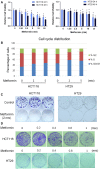
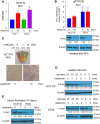

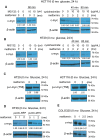
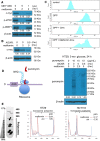
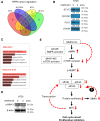
Similar articles
-
Regulation of eukaryotic initiation factor 4E (eIF4E) phosphorylation by mitogen-activated protein kinase occurs through modulation of Mnk1-eIF4G interaction.Mol Cell Biol. 2010 Nov;30(21):5160-7. doi: 10.1128/MCB.00448-10. Epub 2010 Sep 7. Mol Cell Biol. 2010. PMID: 20823271 Free PMC article.
-
Ribavirin Inhibits the Activity of mTOR/eIF4E, ERK/Mnk1/eIF4E Signaling Pathway and Synergizes with Tyrosine Kinase Inhibitor Imatinib to Impair Bcr-Abl Mediated Proliferation and Apoptosis in Ph+ Leukemia.PLoS One. 2015 Aug 28;10(8):e0136746. doi: 10.1371/journal.pone.0136746. eCollection 2015. PLoS One. 2015. PMID: 26317515 Free PMC article.
-
Structural basis for competitive inhibition of eIF4G-Mnk1 interaction by the adenovirus 100-kilodalton protein.J Virol. 2004 Jul;78(14):7707-16. doi: 10.1128/JVI.78.14.7707-7716.2004. J Virol. 2004. PMID: 15220445 Free PMC article.
-
Phosphorylation of the cap-binding protein eIF4E by the MAPK-activated protein kinase Mnk1.Biochem Pharmacol. 2000 Oct 15;60(8):1237-43. doi: 10.1016/s0006-2952(00)00429-9. Biochem Pharmacol. 2000. PMID: 11007962 Review.
-
MNK, mTOR or eIF4E-selecting the best anti-tumor target for blocking translation initiation.Eur J Med Chem. 2023 Nov 15;260:115781. doi: 10.1016/j.ejmech.2023.115781. Epub 2023 Sep 1. Eur J Med Chem. 2023. PMID: 37669595 Review.
Cited by
-
Counteracting Chemoresistance with Metformin in Breast Cancers: Targeting Cancer Stem Cells.Cancers (Basel). 2020 Sep 1;12(9):2482. doi: 10.3390/cancers12092482. Cancers (Basel). 2020. PMID: 32883003 Free PMC article. Review.
-
Action Mechanism of Metformin and Its Application in Hematological Malignancy Treatments: A Review.Biomolecules. 2023 Jan 29;13(2):250. doi: 10.3390/biom13020250. Biomolecules. 2023. PMID: 36830619 Free PMC article. Review.
-
Yin Yang 1 suppresses tumor invasion and metastasis in nasopharyngeal carcinoma by negatively regulating eIF4E transcriptional activity and expression.Am J Cancer Res. 2023 Aug 15;13(8):3763-3780. eCollection 2023. Am J Cancer Res. 2023. PMID: 37693135 Free PMC article.
-
Metformin Inhibits Tumor Metastasis through Suppressing Hsp90α Secretion in an AMPKα1-PKCγ Dependent Manner.Cells. 2020 Jan 7;9(1):144. doi: 10.3390/cells9010144. Cells. 2020. PMID: 31936169 Free PMC article.
-
Obesity under the moonlight of c-MYC.Front Cell Dev Biol. 2023 Dec 5;11:1293218. doi: 10.3389/fcell.2023.1293218. eCollection 2023. Front Cell Dev Biol. 2023. PMID: 38116204 Free PMC article. Review.
References
-
- Blandino G, Valerio M, Cioce M, Mori F, Casadei L, Pulito C, Sacconi A, Biagioni F, Cortese G, Galanti S et al (2012) Metformin elicits anticancer effects through the sequential modulation of DICER and c‐MYC. Nat Commun 3, 865. - PubMed
Publication types
MeSH terms
Substances
Associated data
- Actions
Grants and funding
LinkOut - more resources
Full Text Sources
Other Literature Sources
Medical
Miscellaneous

